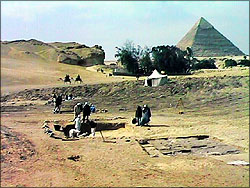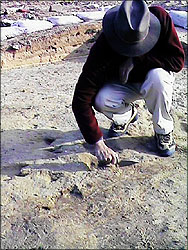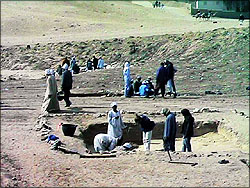
|
Newsflash
February 7, 1997: Excavation Begins
By John Nolan
 The past three days have seen hectic activity at both the excavation site and
in the storeroom to prepare for digging on site in the morning. After moving
most of the modern sand that covered the site, our primary concern was to
locate as precisely as possible the corner pins of our previous season. Once
these were uncovered, more modern sand was removed in the general vicinity of
the areas in which we might wish to dig later in the season. Such foreplanning
is necessary due to the intensive labor required to move this much earth.
Later, when careful excavation calls for more precise work, and fewer people,
some of the workers can go back to clearing backfill from other areas of the
site.
The past three days have seen hectic activity at both the excavation site and
in the storeroom to prepare for digging on site in the morning. After moving
most of the modern sand that covered the site, our primary concern was to
locate as precisely as possible the corner pins of our previous season. Once
these were uncovered, more modern sand was removed in the general vicinity of
the areas in which we might wish to dig later in the season. Such foreplanning
is necessary due to the intensive labor required to move this much earth.
Later, when careful excavation calls for more precise work, and fewer people,
some of the workers can go back to clearing backfill from other areas of the
site.
 After we removed the backfill from the three five by five meter "squares"
(excavation areas in the shape of a square, precisely defined by iron stakes
set five meters apart) which were excavated in 1995, Carl Andrews, team
photographer and computer guy, Noubie Abdul Baset, surveyor's assistant, and
Dr. Lehner used the new Sokkia theodolite to lay out the new squares to be dug
this year.
After we removed the backfill from the three five by five meter "squares"
(excavation areas in the shape of a square, precisely defined by iron stakes
set five meters apart) which were excavated in 1995, Carl Andrews, team
photographer and computer guy, Noubie Abdul Baset, surveyor's assistant, and
Dr. Lehner used the new Sokkia theodolite to lay out the new squares to be dug
this year.
These new squares run along the projected path of the southern wall of the
large building used for bread baking and fish processing. It is in these
squares that we hope to find either the continuation of this large,
meter-and-a-half wide mudbrick wall, or its corner, to help determine the
overall size of the building.
 Other areas which may be excavated this season were also laid out using the
theodolite. These include areas following the north-south extension of the
mudbrick wall (remember that we are working away from the southeastern corner
of this enclosure wall, which was discovered in 1991), as well as a square some
distance to the northwest, closer to the center of the area which may be
enclosed by the wall. However, it is in the squares which we will be opening
tomorrow where we hope to find out how far west the southern wall runs.
Other areas which may be excavated this season were also laid out using the
theodolite. These include areas following the north-south extension of the
mudbrick wall (remember that we are working away from the southeastern corner
of this enclosure wall, which was discovered in 1991), as well as a square some
distance to the northwest, closer to the center of the area which may be
enclosed by the wall. However, it is in the squares which we will be opening
tomorrow where we hope to find out how far west the southern wall runs.
At the storeroom two procedures have been underway, in addition to the
never-ending task of organizing our new space. The most important work has
been processing the back-logged pottery from the archaeological layer (or,
what our project calls a "feature") which was discarded by the bakeries when
they were in use. By processing this massive (more than 1000 kilograms)
amount of ceramic, we hope to determine what kinds of activities were carried
out, and for how long. As it now stands, most of this pottery has been
sorted, but much more detailed analysis has yet to be done in the afternoons
to come.
In addition to this pottery sorting the "heavy fraction" from all our
previous
seasons has finally been sorted as well. The "heavy fraction" consists of the
largest objects which are strained out from soil samples as they are processed
by our paleobotanist. Wilma Wetterstrom, our paleobotanist in 1988-1989 and
1991, ran these samples, mixed with water, through a series of finer and finer
mesh sieves, to extract the seeds, pollen, and grain left behind. This
evidence not only gives us clues as to how our archaeological features were
deposited, but also tells the story of the ancient environment.
The large objects contained in the "heavy fraction" can be bone, worked flint
and mud sealings. Sealings are pieces of the fine, clean mud which the ancient
Egyptians used to seal up their pottery jars, basket boxes and doors. In the
Old Kingdom, they would roll cylindrical pieces of stone, inscribed with
hieroglyphs or designs, over the mud when it was still wet, leaving behind
written impressions. When this mud dries, it becomes so hard that it does
not dissolve, even in our flotation machine. The words and designs left on
these sealings help us to assign a date to our site.
Until today, all the excavators have been spending their days in the
storeroom. Beginning tomorrow, we will excavate in the mornings, and will
spend our afternoons working in the storeroom.
(previous newsflash)
(table of contents)
Photos: Carl Andrews
Pyramids Home | Pyramids | Excavation
Contents | Mail
|